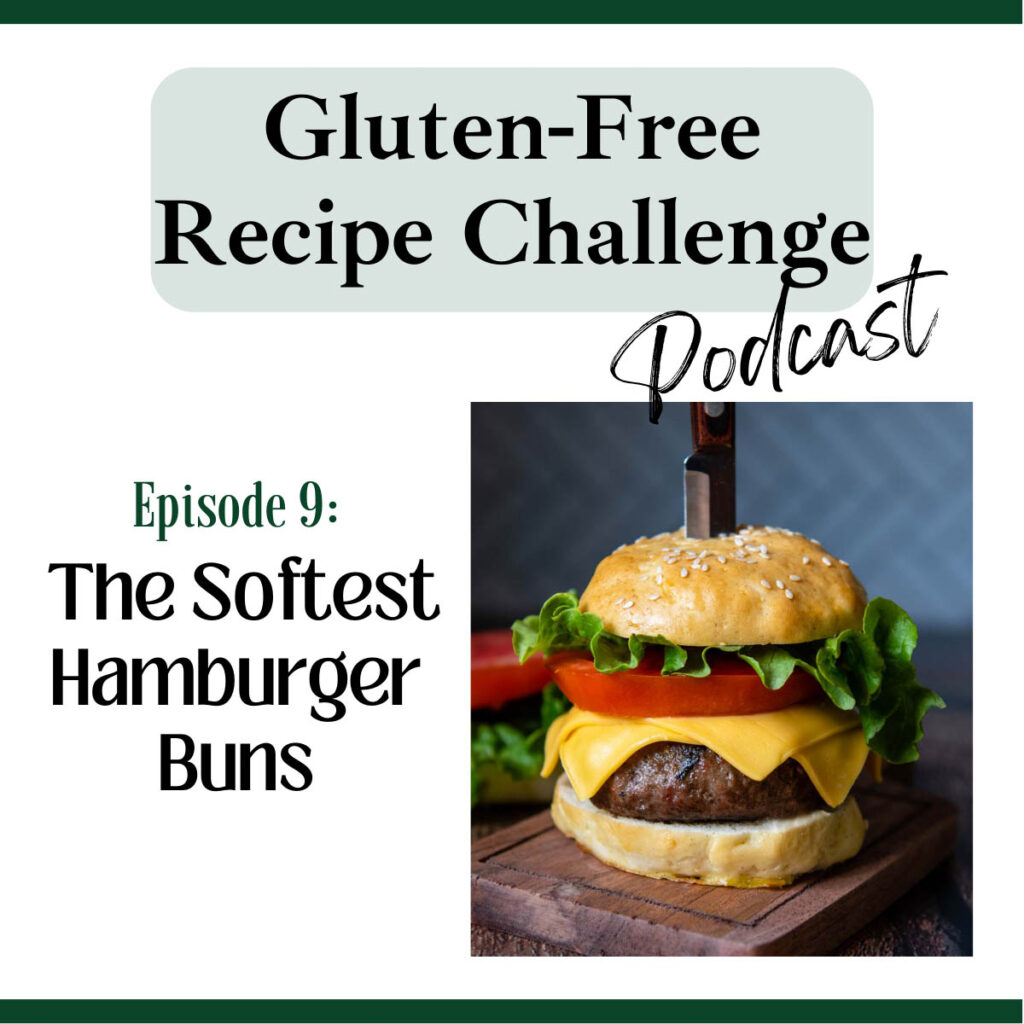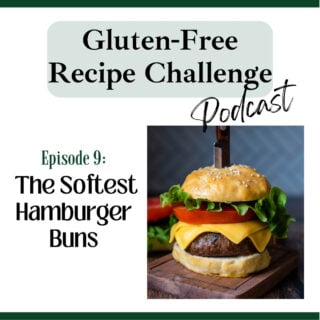In episode 09 learn how to make and enjoy soft, squishy gluten-free burger buns taste even better than you remember with a hint of sweet, buttery flavor. Not only is this recipe easy to make, but has the same texture of traditional burger buns! Join Melissa Erdelac, gluten-free cookbook and website author (Mamagourmand), as she shares many easy, pro tips to make this audio recipe for gluten-free hamburger buns in less than an hour!

Listen to this episode, along with the full audio library, on iTunes, Spotify, Stitcher, TuneIn, or your favorite podcast player.
Recipes and Resources Mentioned
Recommended Equipment
- Kitchen-Aid Stand Mixer
- Flex Edge Paddle Attachment
- Food Scale
- Instant Read Thermometer (Thermoworks)
Recommended ingredients
Follow Along
Don’t forget to subscribe to our weekly newsletter! Besides receiving an immediate GLUTEN-FREE BAKING BONUS, this weekly newsletter gives you direct access to the newest recipes, helping you with menu planning and exclusive tips!
Transcript
Hello all. I’m Melissa Erdelac, host of the Gluten-Free Recipe Challenge podcast and creator behind the gluten-free website, MamaGourmand. Here we take beloved recipes you thought you’d never enjoy again and transform them into easy copycat versions. Just as good as the originals.
I’ve lived over a decade eating naked bunless burgers. Of course, I know a lot of restaurants charge a premium for a horrific substitute, and sometimes I have a total lapse of judgment and I get suckered into it. But what follows is me being pissed again. I spent extra money on a shitty bun. I end up taking off and eating the plain-ass burger anyway.
I just thought a soft pillowy burger bun was like the mythical unicorn of gluten-free baking. But as I created more and more bread recipes, I figured out ways to shape and structure GF bread without drying it out. So why wouldn’t this work for burger buns?
I was ready to slay the dragon and I did. Plus good news for us. All those regular wheat flour bakers get a suck at when making their homemade buns.
This method is actually a lot easier and quicker. They only have one quick rise and they’re ready to serve an under an hour.
So what’s the trick? Why does this recipe get all the extra soft texture, and why are all those other buns still horrible and disgusting and completely inedible?
And I’m not just saying that. These buns are actually awesome. When I serve ’em to my family they actually don’t even know they’re eating gluten-free buns. In fact, the kids end up taking off the burgers and just eating the buns on their own.
So the trick is two parts. One is using psyllium husk powder. I talk about this a lot in episode seven and why I’m so game for it in gluten-free bread baking especially, but cliff notes, the psyllium helps maintain moisture, and it prevents the rolls from becoming crumbly so you don’t have to add as much flour to the mixture and still have that dough be able to be shaped. And it kind of mimics the effects of gluten, which is missing in gluten-free recipes.
Second, I also replace some of the flour with potato starch, and I’m talking about potato starch here, not potato flour. So potato flour are actual potatoes that are cooked. They’re dried and they’re ground into a flour.
The starch is that residue. If you’ve ever soaked potatoes in water, it’s like that residue that falls to the bottom. That residue is extracted, it’s dried and it’s ground into a flour. Ways bakers use potato starch, it’s generally used as a binder, kind of like corn starch, and it also has a similar texture. It has that real fine powdery texture to it.
Replacing some of the flour with potato starch takes away the denseness . So you still have that binder. And you still have something building structure in the dough, but it’s a little more light and airy so it doesn’t weigh it down.
For best results, I recommend using the potato starch and it’s really affordable. Bob’s Red Mill makes it, and you could get it off of Amazon or I’ve seen it at my local grocery store, but if you don’t wanna buy another ingredient, the other thing you could use is just additional gluten-free flour, although the results won’t be quite as fluffy, or you could use tapioca starch as well.
Okay, so what else are you gonna need for this recipe? The most important ingredient, a quality gluten-free, all-purpose flour. I always use Cup4Cup. It mimics the taste and texture of regular wheat recipes, pretty much identically.
I’ve done a lot of testing with the all-purpose, gluten-free flours, and Cup4Cup really outperforms them all. It does contain a little bit of milk powder in it, so if you need a gluten-free and dairy-free hamburger bun recipe, I recommend using King Arthur Measure-for-Measure in its place.
But if you don’t, I would spring a little extra money and get the Cup4Cup. It makes a world a difference, especially in this recipe because Cup4Cup also has corn starch in it, which lightens the starches and makes the recipe a little bit more airy.
The other thing you’ll need is the psyllium husk powder, which I mentioned, and I’ll link to that.
The one that I use, it’s like a blonde psyllium husk powder, so it won’t change the color of your baked goods. It won’t make ’em darker and make ’em look kind of like a wheat flour recipe. I will link to the one that I use , and you could get it off Amazon.
I use a combination of baking powder and yeast, and I rely on this twofold method just to get a good rise. The yeast activates the dough when it’s mixed and while it briefly rises, but the baking powder assists it even more when it’s in the oven as it’s baking.
You will also need eggs and I recommend room temperature eggs. And I always forget to set out the damn eggs to make ’em room temperature. What I do is I just leave the eggs in the shell and I put ’em in a bowl of hot water for five minutes and walla room temperature.
You also need a little bit of sugar, which adds a bit of sweetness to the dough, and it also helps feed the yeast. And then butter. Butter adds flavor and it also coats the gluten-free starches to eliminate any grittiness. If you do need a dairy-free recipe, you could also use plant based butter.
Okay, so let’s make the dough. It’s actually pretty simple to make. First, you’re just gonna line a baking sheet with greased parchment paper. Then take a small bowl and add together the yeast, the sugar, and the warm water. For the water, I always use my instant read thermometer just to make sure the water is the right temperature.
It should be 110 degrees, and I will link to my thermometer in the show notes. I love this version in particular because it reads temperatures in one second.
Once you’ve combined that, let it sit for five minutes and then add in the melted butter and your egg. While the yeast sits, use your stand mixer with a paddle attachment, and combine your dry ingredients, so put in the flour, the potato starch, the psyllium husk, baking powder and salt. Just mix that together in the bowl on low speed.
Then add in the yeast mixture and continue mixing it on low speed just to combine. Once it all comes together, increase the speed to medium and beat it for six minutes, and that’s it.
The dough at this point will be pretty stiff, but it’ll still be a little sticky and that’s fine. The reason that I like gluten-free dough to be a little stickier, that means that you haven’t oversaturated it with gluten-free flour to make it so it’s easier to shape, but then it ends up being dry and crumbly.
Instead of adding more flour, making it easier to shape, I just use a couple easy tricks to counteract the stickiness and be able to handle the dough with without being completely frustrating.
What you do is take a one-third measuring cup and spray it with non-stick cooking spray, and scoop out the dough into the measuring cup. So an even one-third is about two ounces of dough, which makes the perfect size burger buns.
The other way you could do this, if you wanna get super technical about it, is use a food scale and put a piece of plastic wrap over the food scale, spray it with non-stick cooking spray and then you could just put enough dough on until it measures two ounces. And that way you know, each burger bun will exactly be the same size.
Once you have your dough, spray your hands with some cooking spray and just roll the dough into a tight ball. While most recipes use flour to avoid stickiness, I don’t wanna add any more flour to the dough, so just use non-stick cooking spray. It works even better.
Place that ball onto your greased baking sheet and then just press it down to flatten. You do this with the remaining of the dough, and then that is your burger buns. They don’t have to be touching. You could just spread them out over the baking sheet. And you should have 12 disks, thick disks.
Once you have all your dough shaped into the burger buns, you will take another piece of plastic wrap, spray it, and then cover it so they don’t dry out while they’re rising.
Now I should have said this at the beginning of the recipe, but you wanna have the dough rise in a really warm area.
To do this, what I do is before I even start mixing together the dough, cuz the dough only takes a few minutes to mix together, I turn on my oven to 200 degrees and once it reaches 200 degrees, you turn off the oven and you just let it sit while you’re mixing together the dough.
Now when you’re ready to the bread in to rise, you have a nice warm oven to put it in. You don’t want it like cooking, but you want the oven temperature to be around 150 degrees. Put the burger buns in for 10 minutes and this jump starts the rise. So they rise really fast. Then after 10 minutes, just take the pan from the oven and let it sit at room temperature for 20 minutes more. And at that point you could preheat your oven to 375.
So you could see how quick these are. They only take about five to 10 minutes to mix together, and then they only rise for 30 minutes, and now you’re ready to bake it.
Before you bake it, if you want your burger buns to be like bakery buns and look super profesh, I take an egg wash, which is just an egg mixed with a little bit of water, and I brush it over the tops of the risen rolls and then sprinkle ’em with sesame seeds.
At this point, you just bake ’em for 15 minutes or until the bottoms are golden brown. Then take ’em out of the oven and let ’em cool completely before you store them.
When you eat these things, I promise you are gonna be blown away. You have never had a burger bun this good. But I do recommend you have ’em the day that you make them. They lose moisture quickly. All gluten-free baked goods do. So I recommend eating them or using them the day you make ’em.
If you need to make them ahead of time, just cool them completely. Wrap each of them up in plastic wrap and put in a Ziploc freezer bag and you could freeze them up to two months. And just pull one out whenever you need it.
When you’re ready to serve them, make sure they’re at room temperature, they can’t be the slightest bit chilled. If they’re chilled, they’ll become a little crumbly.
You want them really room temperature or you could even stick ’em in the microwave for like 10 seconds and they will be just as good as the day you baked them.
I promise you, when you try these things, you’re gonna be like, hot damn, I cannot believe I’m having a good hamburger bun again. They are incredible.
So that’s all for this episode of the Gluten-Free Recipe Challenge. Remember, you could always find the full printable recipe on the show notes page. And to get to that, go to my recipe website, mamagourmand.com, and click on the podcast tab. Or you can also view it on the link provided in whatever podcast app you’re listening on. The show notes is going to include the full recipe, any tips I’ve mentioned along with any recommended ingredients or equipment I’ve talked about. Also, if you could do me, one last thing. If you’re enjoying this podcast, please subscribe to it so you don’t miss any new episodes. Then also, if you could leave me a comment and rate it, I’d be so appreciative.


Anita says
Instead of parchment paper can you use a silicon mat?
Melissa Erdelac says
Hi Anita,
Yes, that wouldn’t be a problem!
Best,
Melissa
Cindy McNeil says
Question – in your GF hamburger podcast you say to make 2 oz dough balls but the recipe says 3 oz. Could you please clarify? Or perhaps I’m misunderstanding. Thanks so much!
Melissa Erdelac says
Hey Cindy,
Thanks for pointing that out! Go with what the recipe says. Sounds like I messed up in the podcast, sorry about that! It’s 3 ounces.
Best,
Melissa